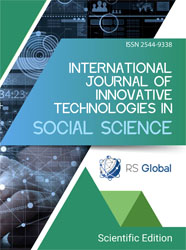CONTROVERSIAL ISSUES REGARDING THE USE OF GADOLINUM-BASED CONTRAST AGENTS – THE LATEST REPORTS
Abstract
Introduction and objective: Gadolinium-based contrast agents (GBCAs) are paramagnetic substances that have been used over the past 30 years in MRI diagnostics, and have significantly improved imaging and diagnostic capabilities for many diseases. Although they are used in small amounts in individual patients, their use worldwide involves the consumption of many thousands of liters of GBCAs per year and is growing. With such widespread demand for contrast-enhanced MRI, there is a need for these agents to be as safe as possible.
Review methods: A comprehensive literature review was conducted, analyzing 33 studies from the PubMed and Google Scholar database (English-language, published within the last 8 years).
Brief description of the state of knowledge: In recent years, much attention has been paid to the fact of gadolinium deposition in tissues and accumulation in the environment, the risk of nephrogenic systemic fibrosis (NSF), and safety issues in use in pregnant patients and the pediatric population. The risk of the above-mentioned events has been shown to vary depending on the type of GBCA, with macrocyclic GBCAs having a lower risk than linear GBCAs. Despite a great number of studies, many issues regarding the clinical significance of the side effects of GBCAs still remain unclear and controversial. Therefore, even more stable and better-performing GBCAs, new MRI approaches requiring lower doses of GBCAs, and alternative contrast agents need to be developed to ensure patient welfare.
Summary: In this review, we will try to present the current state of knowledge on the above-mentioned issues with a perspective of the future of this branch of medicine.
References
Parillo M, Mallio CA, Van der Molen AJ, Rovira À, Dekkers IA, Karst U, Stroomberg G, Clement O, Gianolio E, Nederveen AJ, Radbruch A, Quattrocchi CC; ESMRMB-GREC Working Group. The role of gadolinium-based contrast agents in magnetic resonance imaging structured reporting and data systems (RADS). MAGMA. 2024 Feb;37(1):15-25. doi: 10.1007/s10334-023-01113-y. Epub 2023 Sep 13. PMID: 37702845; PMCID: PMC10876744.
Runge VM (2017) Critical questions regarding gadolinium deposition in the brain and body after injections of the gadolinium-based contrast agents, safety, and clinical recommendations in consideration of the EMA’s Pharmacovigilance and Risk Assessment Committee recommendation for suspension of the marketing authorizations for 4 linear agents. Invest Radiol 52:317–323
Weinreb JC, Rodby RA, Yee J, Wang CL, Fine D, McDonald RJ, Perazella MA, Dillman JR, Davenport MS. Use of Intravenous Gadolinium-based Contrast Media in Patients with Kidney Disease: Consensus Statements from the American College of Radiology and the National Kidney Foundation. Radiology. 2021 Jan;298(1):28-35. doi: 10.1148/radiol.2020202903. Epub 2020 Nov 10. PMID: 33170103.
Coimbra S, Rocha S, Sousa NR, Catarino C, Belo L, Bronze-da-Rocha E, Valente MJ, Santos-Silva A. Toxicity Mechanisms of Gadolinium and Gadolinium-Based Contrast Agents-A Review. Int J Mol Sci. 2024 Apr 6;25(7):4071. doi: 10.3390/ijms25074071. PMID: 38612881; PMCID: PMC11012457.
Scarciglia A, Papi C, Romiti C, Leone A, Di Gregorio E, Ferrauto G. Gadolinium-Based Contrast Agents (GBCAs) for MRI: A Benefit-Risk Balance Analysis from a Chemical, Biomedical, and Environmental Point of View. Glob Chall. 2025 Jan 23;9(3):2400269. doi: 10.1002/gch2.202400269. PMID: 40071223; PMCID: PMC11891575.
Shamam YM, Hashmi MF, De Jesus O. Nephrogenic Systemic Fibrosis. 2024 Nov 1. In: StatPearls [Internet]. Treasure Island (FL): StatPearls Publishing; 2025 Jan–. PMID: 33620831.
Lange S, Mędrzycka-Dąbrowska W, Zorena K, Dąbrowski S, Ślęzak D, Malecka-Dubiela A, Rutkowski P. Nephrogenic Systemic Fibrosis as a Complication after Gadolinium-Containing Contrast Agents: A Rapid Review. Int J Environ Res Public Health. 2021 Mar 15;18(6):3000. doi: 10.3390/ijerph18063000. PMID: 33804005; PMCID: PMC8001337.
Woolen SA, Shankar PR, Gagnier JJ, MacEachern MP, Singer L, Davenport MS. Risk of nephrogenic systemic fibrosis in patients with stage 4 or 5 chronic kidney disease receiving a group II gadolinium-based contrast agent: a systematic review and meta-analysis. JAMA Intern Med. 2020;180:223–230. doi: 10.1001/jamainternmed.2019.5284.
Welker KM, Joyner D, Kam AW, Liebeskind DS, Saindane AM, Segovis C, Yahyavi-Firouz-Abadi N, Jordan JE. State of Practice: ASNR Statement on Gadolinium-Based Contrast Agent Use in Patients with Chronic Kidney Disease. AJNR Am J Neuroradiol. 2025 Feb 3;46(2):227-230. doi: 10.3174/ajnr.A8501. PMID: 39284636; PMCID: PMC11878962.
Starekova J, Bruce RJ, Sadowski EA, Reeder SB. No cases of nephrogenic systemic fibrosis after administration of gadoxetic acid. Radiology . 2020;297(3):556–62. doi: 10.1148/radiol.2020200788.
Cheong BYC, Wilson JM, Preventza OA, Muthupillai R. Gadolinium-Based Contrast Agents: Updates and Answers to Typical Questions Regarding Gadolinium Use. Tex Heart Inst J. 2022 May 1;49(3):e217680. doi: 10.14503/THIJ-21-7680. PMID: 35612906; PMCID: PMC9242635.
Schieda N., Blaichman J.I., Costa A.F., Glikstein R., Hurrell C., James M., Jabehdar Maralani P., Shabana W., Tang A., Tsampalieros A., et al. Gadolinium-Based Contrast Agents in Kidney Disease: Comprehensive Review and Clinical Practice Guideline Issued by the Canadian Association of Radiologists. Can. Assoc. Radiol. J. 2018;69:136–150. doi: 10.1016/j.carj.2017.11.002.
American College of Radiology (2020) Manual on contrast media, Version 10.3. ACR website. https://www.acr.org/ClinicalResources/Contrast-Manual. Accessed 16 May 2020
Gui B, Cambi F, Micco M, Sbarra M, Petta F, Autorino R et al. MRI in pregnant patients with suspected abdominal and pelvic cancer: a practical guide for radiologists. Diagn Interv Radiol . 2020;26(3):183–92. doi: 10.5152/dir.2019.19343.
Risk of fetal or neonatal death or neonatal intensive care unit admission associated with gadolinium magnetic resonance imaging exposure during pregnancy. Winterstein AG, Thai TN, Nduaguba S, et al. https://doi.org/10.1016/j.ajog.2022.10.005. Am J Obstet Gynecol. 2023;228:465–411. doi: 10.1016/j.ajog.2022.10.005.
Association between MRI exposure during pregnancy and fetal and childhood outcomes. Ray JG, Vermeulen MJ, Bharatha A, Montanera WJ, Park AL. JAMA. 2016;316:952–961. doi: 10.1001/jama.2016.12126.
Increased stillbirths and neonatal deaths following GBCA-enhanced MRI: a population-based study. Ray J, Smith D, Brown R. J Perinat Med. 2022;50:234–240.
Little, J. T., & Bookwalter, C. A. (2020). Magnetic Resonance Safety. Magnetic Resonance Imaging Clinics of North America. doi:10.1016/j.mric.2020.06.002
Blumfield E, Swenson DW, Iyer RS, Stanescu AL (2019) Gadolinium-based contrast agents — review of recent literature on magnetic resonance imaging signal intensity changes and tissue deposits, with emphasis on pediatric patients. Pediatr Radiol 49: 448–457
Zhang Y, Cao Y, Shih GL et al (2017) Extent of signal hyperintensity on unenhanced T1-weighted brain MR images after more than 35 administrations of linear gadolinium-based contrast agents. Radiology 282:516–525
Quattrocchi CC, van der Molen AJ. Gadolinium Retention in the Body and Brain: Is It Time for an International Joint Research Effort? Radiology. 2017 Jan;282(1):12-16. doi: 10.1148/radiol.2016161626. PMID: 28005498.
McDonald RJ, McDonald JS, Kallmes DF et al (2017) Gadolinium deposition in human brain tissues after contrast-enhanced MR imaging in adult patients without intracranial abnormalities. Radiology 285:546–554
Stanescu AL, Shaw DW, Murata N et al (2020) Brain tissue gadolinium retention in pediatric patients after contrast-enhanced magnetic resonance exams: pathological confirmation. Pediatr Radiol 50:388–396
McDonald RJ, Levine D, Weinreb J et al (2018) Gadolinium retention: a research roadmap from the 2018 NIH/ACR/RSNA workshop on gadolinium chelates. Radiology 289:517–534
Brünjes R, Hofmann T (2020) Anthropogenic gadolinium in freshwater and drinking water systems. Water Res 182:115966
Lenkinski RE, Rofsky NM. Contrast Media-driven Anthropogenic Gadolinium: Knowns and Unknowns. Radiology. 2024 Apr;311(1):e240020. doi: 10.1148/radiol.240020. PMID: 38652027.
Dekker HM, Stroomberg GJ, Van der Molen AJ, Prokop M. Review of strategies to reduce the contamination of the water environment by gadolinium-based contrast agents. Insights Imaging. 2024 Feb 27;15(1):62. doi: 10.1186/s13244-024-01626-7. PMID: 38411847; PMCID: PMC10899148.
Liu Z, Guo C, Tai P et al (2021) The exposure of gadolinium at environmental relevant levels induced genotoxic effects in Arabidopsis thaliana (L.). Ecotoxicol Environ Saf 215:112138
Trapasso G, Chiesa S, Freitas R, Pereira E (2021) What do we know about the ecotoxicological implications of the rare earth element gadolinium in aquatic ecosystems? Sci Total Environ 781:146273
Cesarini G, Spani F, Patricelli R et al (2024) Assessing teratogenic risks of gadolinium in freshwater environments: implications for environmental health. Ecotoxicol Environ Saf 278:116442
Loevner LA, Kolumban B, Hutóczki G et al (2023) Efficacy and safety of gadopiclenol for contrast-enhanced mri of the central nervous system: the PICTURE randomized clinical trial. Invest Radiol. 10.1097/RLI.0000000000000944
Lohrke J, Berger M, Frenzel T et al (2022) Preclinical profile of gadoquatrane: a novel tetrameric, macrocyclic high relaxivity gadolinium-based contrast agent. Invest Radiol 57:629–638. 10.1097/RLI.0000000000000889 10.1097/RLI.0000000000000889
Shuvaev S, Akam E, Caravan P (2021) Molecular MR contrast agents. Invest Radiol 56:20–34. 10.1097/RLI.0000000000000731 10.1097/RLI.0000000000000731
Views:
36
Downloads:
16
Copyright (c) 2025 Małgorzata Piekarska-Kasperska, Julia Błoniecka, Jan Kamiński, Anna Daniel, Natalia Kraciuk, Radosław Kasperski, Kacper Jankowski, Alicja Bury, Karol Bartecki

This work is licensed under a Creative Commons Attribution 4.0 International License.
All articles are published in open-access and licensed under a Creative Commons Attribution 4.0 International License (CC BY 4.0). Hence, authors retain copyright to the content of the articles.
CC BY 4.0 License allows content to be copied, adapted, displayed, distributed, re-published or otherwise re-used for any purpose including for adaptation and commercial use provided the content is attributed.















